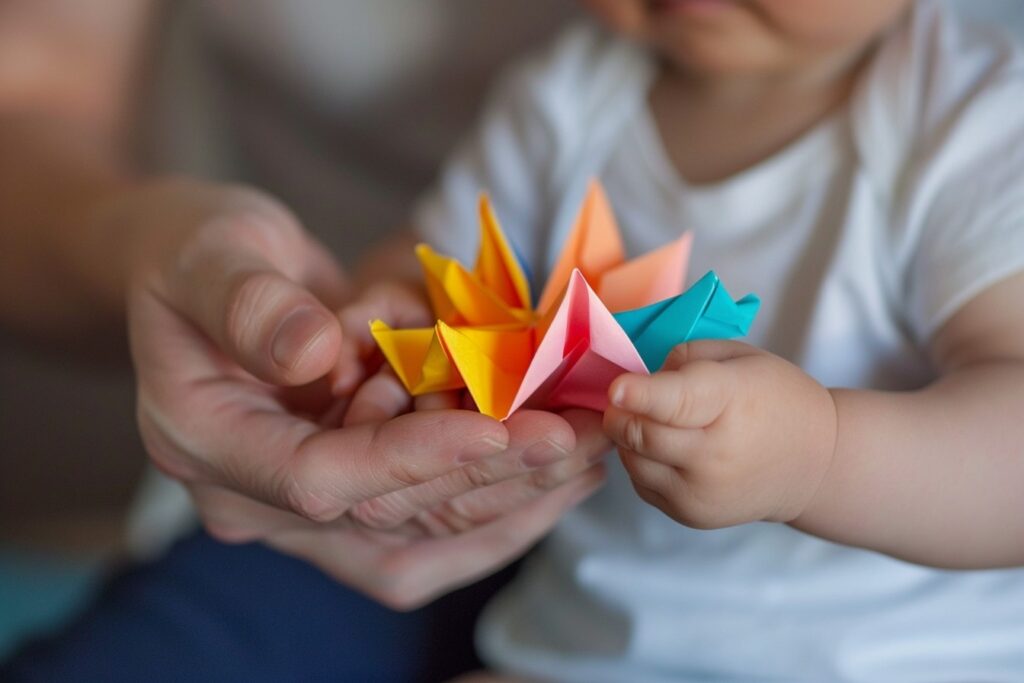Table of Contents
ToggleOrigami for Toddlers: Easy Paper Folding Fun
Inspiring and Intriguing Introduction
Picture this: a cozy afternoon bathed in sunlight, where the giggles of a toddler fill the air as they sit wide-eyed, fingers delicately folding a piece of paper. What seems like a simple pastime holds within it a world of wonder and discovery. Welcome to the enchanting realm of origami for toddlers!
In today’s fast-paced digital age, finding activities that captivate and engage toddlers away from screens can feel like a Herculean task. As parents, we’re constantly seeking enriching experiences that not only entertain but also nurture our little ones’ budding minds and creativity.
Origami, the ancient Japanese art of paper folding, offers a magical solution. It’s more than just the act of folding paper; it’s a journey of exploration, learning, and connection. From fostering fine motor skills to sparking imaginative play, origami holds a myriad of benefits for toddlers.
Join me as we embark on a delightful adventure into the world of origami for toddlers, where simple folds and creases open doors to boundless imagination and endless possibilities.
But before we delve into the intricate folds and whimsical creations, let’s take a moment to understand the essence of origami and its significance in our children’s lives.
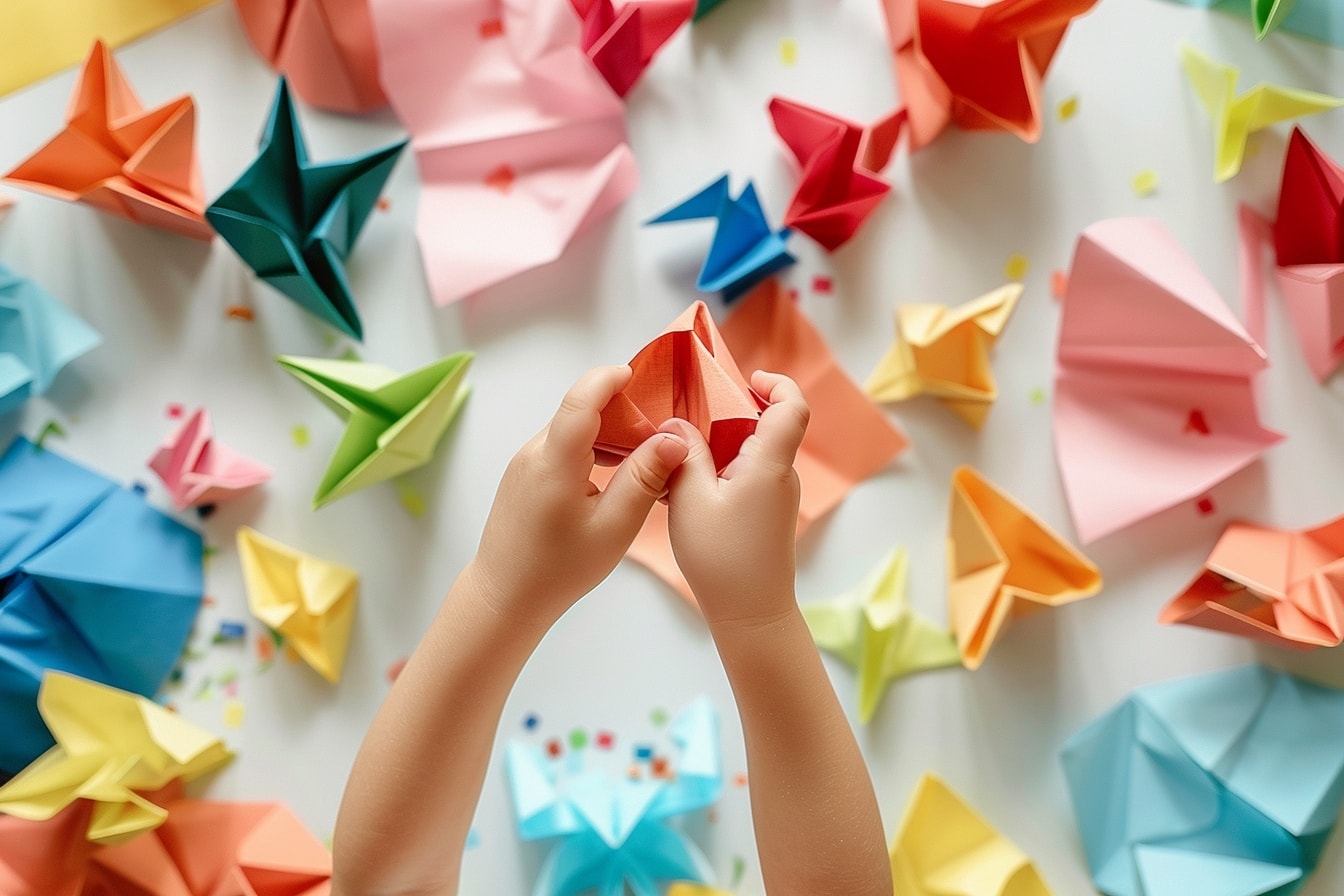
Unlocking Creativity with Origami
Origami isn’t just about folding paper; it’s about igniting a spark of creativity in our little ones that can light up their world. As parents, we cherish the moments when we witness our children’s imaginations take flight, and origami provides the perfect canvas for those magical moments to unfold.
Picture the wonder in your toddler’s eyes as they transform a simple square of paper into a soaring bird or a playful frog. With each fold and crease, they’re not just following instructions; they’re exploring shapes, textures, and possibilities.
But beyond the tangible results, origami nurtures essential skills that lay the foundation for lifelong learning. From enhancing fine motor skills to stimulating spatial awareness, the benefits of origami extend far beyond the craft table.
- Developing Fine Motor Skills: The intricate folds and delicate maneuvers required in origami help strengthen the muscles in toddlers’ hands and fingers, improving their dexterity and coordination. As they carefully manipulate the paper, they’re honing the same skills they’ll later use for writing, drawing, and other tasks.
- Fostering Patience and Persistence: In a world where instant gratification often reigns supreme, origami teaches toddlers the value of patience and perseverance. As they encounter challenges and setbacks along the way, they learn to approach problems with a resilient mindset, trying again and again until they succeed.
- Encouraging Spatial Awareness: Origami requires toddlers to visualize and manipulate shapes in three dimensions, helping them develop spatial reasoning skills that are essential for understanding concepts like size, shape, and distance. As they fold and unfold the paper, they’re honing their spatial awareness in a hands-on and tangible way.
But perhaps most importantly, origami sparks creativity in its purest form. As toddlers experiment with different folds and designs, they’re not just following a set of instructions; they’re becoming architects of their own miniature worlds. From imagining fantastical creatures to inventing new shapes, origami empowers toddlers to explore their imaginations and express themselves in a unique and beautiful way.
So let’s embrace the magic of origami and watch as our toddlers’ creativity takes flight, one fold at a time.
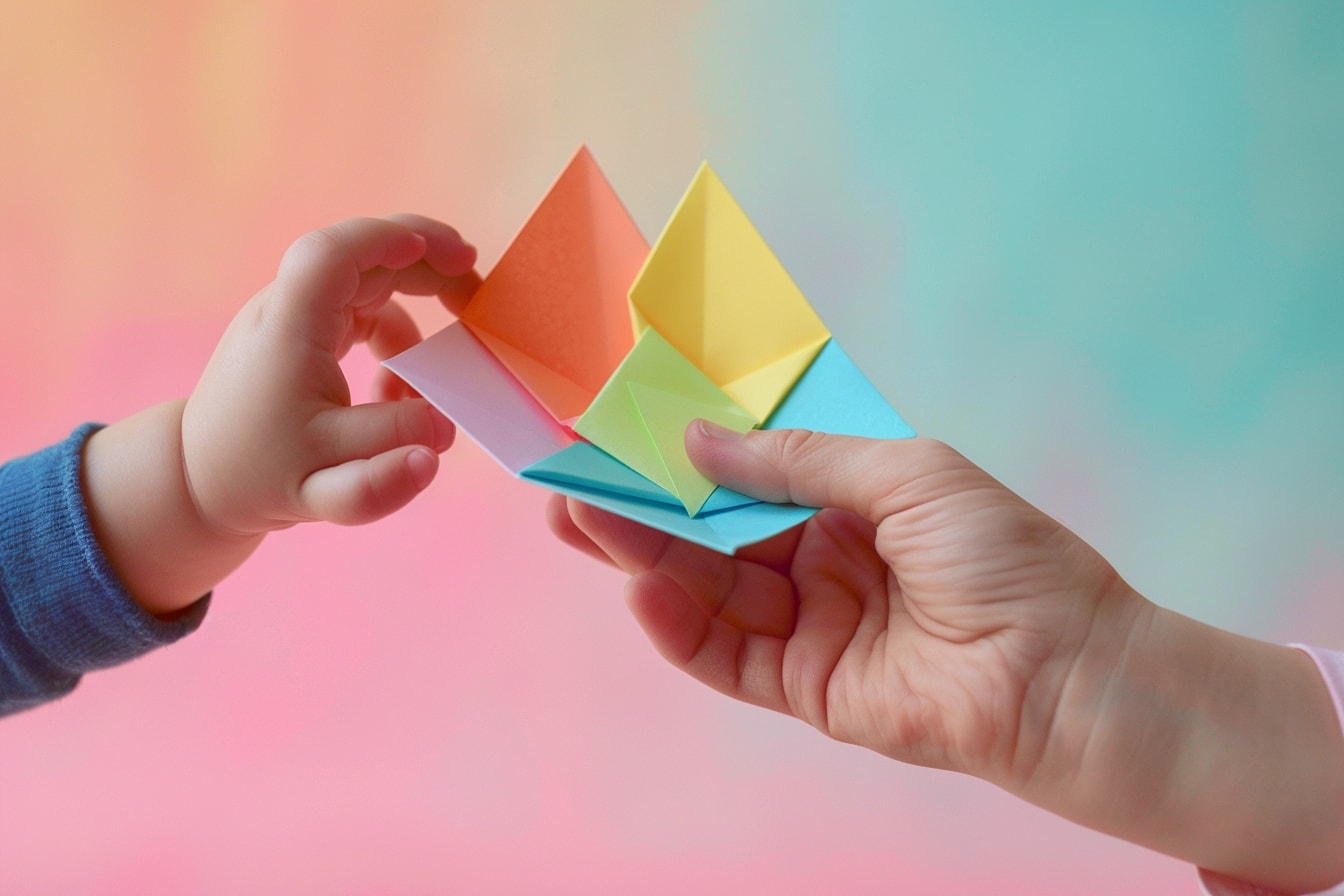
Introduction to Origami for Toddlers
Welcome to the enchanting world of origami, where a simple sheet of paper holds the promise of endless possibilities. But what exactly is origami, and how can we introduce this ancient art form to our curious toddlers?
Origami, derived from the Japanese words ori (folding) and kami (paper), is the art of transforming a flat sheet of paper into a three-dimensional masterpiece through a series of folds and creases. What sets origami apart is its simplicity; all you need is paper and your hands to create something beautiful.
But origami is more than just a craft; it’s a journey of exploration and discovery for toddlers. As they manipulate the paper, they’re not just learning about shapes and structures; they’re developing crucial skills that will serve them well throughout their lives.
- Fine Motor Skills: Origami encourages toddlers to use their hands in precise and controlled ways, strengthening the muscles in their fingers and improving their coordination. As they grasp and fold the paper, they’re refining their fine motor skills without even realizing it.
- Problem-Solving Abilities: Every fold in origami presents a new challenge for toddlers to solve. Whether it’s figuring out how to create a perfect crease or making a complex shape come to life, origami teaches toddlers to think critically and creatively as they work through each step of the folding process.
- Patience and Persistence: Origami requires toddlers to follow a sequence of steps with precision and care. As they encounter difficulties or mistakes along the way, they learn the value of patience and persistence, persevering until they achieve their desired result.
But perhaps the most magical aspect of origami is its ability to capture the imagination of toddlers. From a simple paper airplane to a whimsical animal, each fold tells a story and invites toddlers to become part of the creative process.
So let’s embark on this journey together, as we introduce our toddlers to the joy and wonder of origami. With a little paper and a lot of imagination, the possibilities are endless!
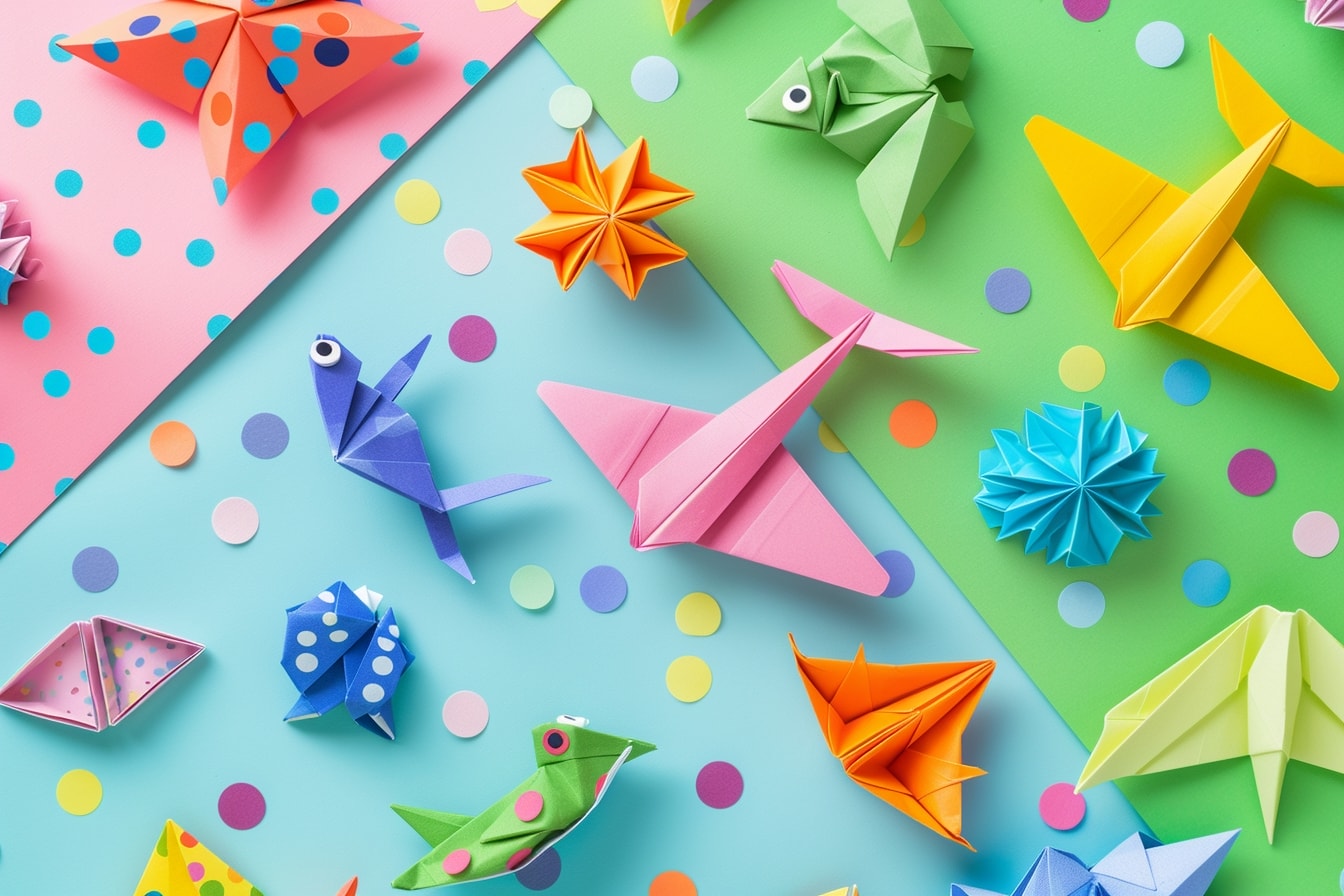
Easy Origami Projects for Toddlers
Now that we’ve dipped our toes into the captivating world of origami, it’s time to roll up our sleeves and embark on some delightful folding adventures with our toddlers. But where to begin? Fear not, dear parents, for I’ve curated a selection of easy origami projects that are perfect for tiny hands and big imaginations.
Origami doesn’t have to be complicated to be enjoyable. In fact, some of the simplest folds can yield the most delightful results. So gather your supplies—some colorful paper and a sprinkle of patience—and let’s dive into our first project!
Paper Airplane
- Materials: A square sheet of paper (preferably lightweight).
- Instructions: Start by folding the paper in half diagonally to form a triangle. Then, fold the top corners down to meet the bottom edge of the triangle, creating two smaller triangles. Finally, fold the wings down along the center crease to complete your paper airplane.
- Tips: Experiment with different paper colors and sizes to create a fleet of unique airplanes. Encourage your toddler to decorate their planes with crayons or markers for added flair!
Watch as your toddler’s eyes light up with excitement as they send their paper airplanes soaring through the air, imagining themselves as fearless aviators navigating the skies.
Jumping Frog
- Materials: A square sheet of green paper (or any color you prefer).
- Instructions: Fold the paper in half horizontally to form a rectangle. Then, fold the top corners down to meet the bottom edge of the rectangle, creating two smaller triangles. Fold the bottom corners up to form legs, and voila! Your jumping frog is ready to hop into action.
- Tips: Use googly eyes or draw on facial features to give your frog some personality. Challenge your toddler to see how far their frog can jump by pressing down on its back and releasing it!
As your toddler’s frog leaps and bounds across the table, their laughter fills the room, reminding you of the simple joys of childhood.
Basic Boat
- Materials: A square sheet of paper (water-resistant paper works best).
- Instructions: Fold the paper in half diagonally to form a triangle. Then, fold the bottom corners up to meet the top corner, creating a smaller triangle. Open up the top layer of the triangle and fold the two side corners in towards the center to form a boat shape. Finally, fold the bottom point of the triangle up to create the boat’s prow.
- Tips: Test your boat’s seaworthiness by floating it in a bowl of water. Encourage your toddler to decorate their boat with stickers or markers to make it truly their own.
As your toddler’s boat sets sail on imaginary seas, they embark on a voyage of imagination and exploration, guided by the gentle currents of their dreams.
So there you have it, dear parents—three simple origami projects to kickstart your toddler’s journey into the magical world of paper folding. Let your imaginations run wild and watch as your little ones’ creativity takes flight with each fold and crease.

Overcoming Challenges
As we embark on our origami journey with our toddlers, it’s essential to recognize that challenges may arise along the way. But fear not, dear parents, for every obstacle presents an opportunity for growth and learning. Let’s explore some common challenges that may arise when introducing origami to toddlers, along with practical strategies for overcoming them.
A. Frustration and Difficulty with Folding
- Challenge: Toddlers may become frustrated or discouraged when they encounter difficulties with folding, leading to tantrums or tears.
- Solution: Patience is key when guiding toddlers through the origami process. Break down each step into manageable tasks, offering gentle encouragement and support along the way. Demonstrate the folding technique with clear, slow movements, allowing your toddler to observe before attempting the fold themselves. Celebrate small victories and remind your toddler that it’s okay to make mistakes; after all, that’s how we learn and grow.
B. Short Attention Spans
- Challenge: Toddlers are notorious for their short attention spans, making it challenging to keep them engaged throughout the origami activity.
- Solution: Keep origami sessions short and sweet, focusing on one project at a time to prevent overwhelm. Choose projects that can be completed within a few minutes, allowing your toddler to experience a sense of accomplishment without losing interest. Break up the folding process with playful activities or snacks to keep your toddler engaged and motivated. And remember, it’s okay to take breaks and revisit the project later if your toddler’s attention wanes.
C. Fine Motor Skill Development
- Challenge: Some toddlers may struggle with the fine motor skills required for precise folding, leading to frustration and feelings of inadequacy.
- Solution: Provide additional support and guidance for toddlers who are still developing their fine motor skills. Offer larger pieces of paper or pre-folded creases to make the folding process more accessible. Encourage your toddler to use both hands to hold and manipulate the paper, strengthening coordination and control. And don’t forget to praise their efforts and progress along the way, reinforcing their confidence and sense of accomplishment.
By acknowledging and addressing these challenges head-on, we can create a positive and nurturing environment for our toddlers to explore the joys of origami. With patience, perseverance, and a sprinkle of creativity, we can overcome any obstacle that comes our way and embark on an origami adventure filled with laughter, learning, and love.
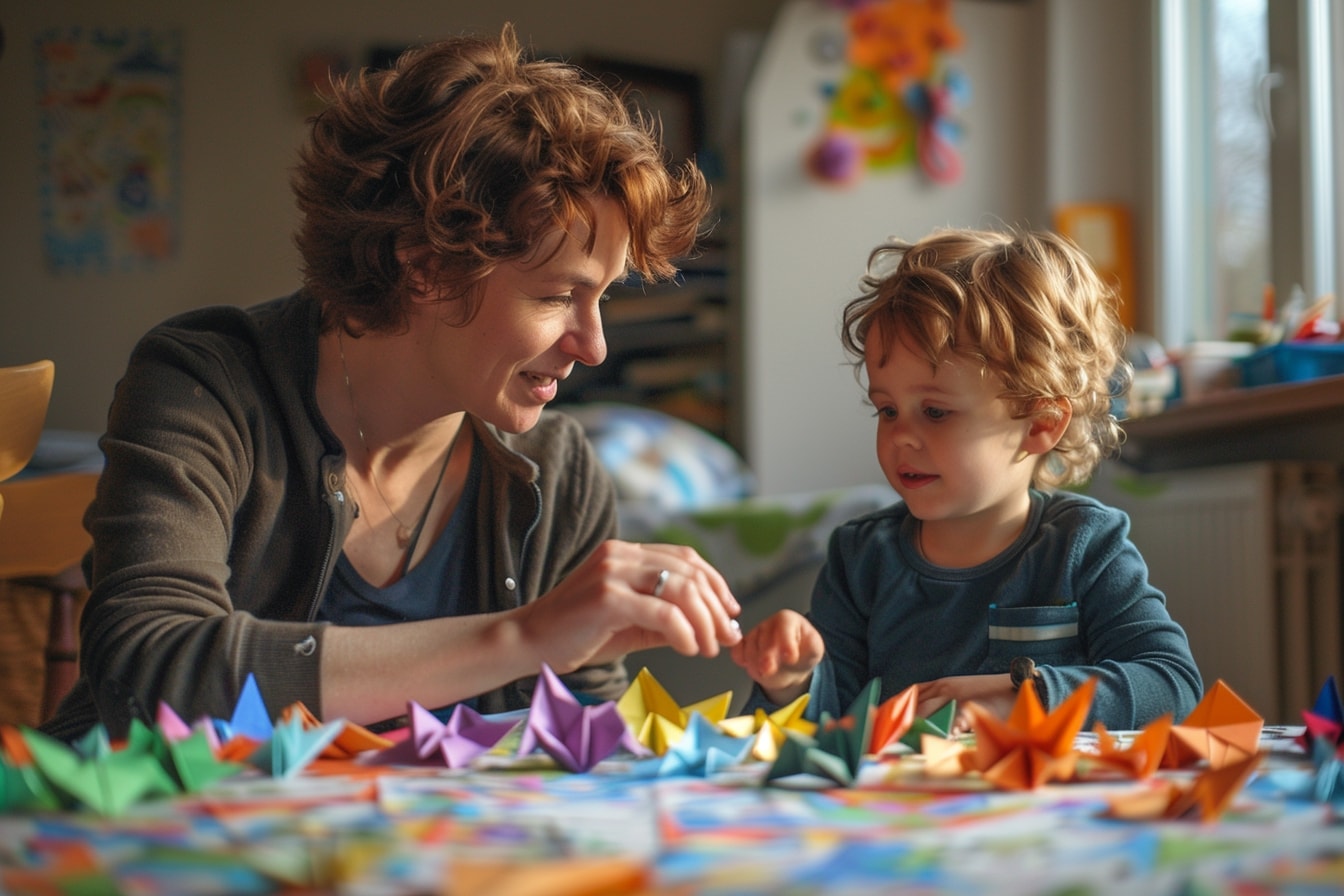
Addressing Common Concerns
As parents, it’s natural to have concerns when introducing new activities to our toddlers, and origami is no exception. But fret not, dear parents, for I’m here to address some of the most common concerns that may arise and offer practical solutions to ease your worries.
A. Safety Risks
- Concern: Parents may worry about potential safety risks associated with origami, such as paper cuts or accidental ingestion of small paper pieces.
- Solution: While it’s essential to supervise toddlers during origami activities, rest assured that the risks are minimal when appropriate precautions are taken. Use lightweight paper with rounded edges to reduce the risk of paper cuts, and avoid small or sharp objects that could pose a choking hazard. Encourage your toddler to fold on a flat, stable surface away from distractions or hazards. And remember, accidents happen, but with vigilance and common sense, we can create a safe and enjoyable origami experience for our little ones.
B. Mess and Clean-Up
- Concern: Parents may worry about the mess and clean-up associated with origami, including scattered paper scraps and crumpled projects.
- Solution: Embrace the mess as part of the creative process and involve your toddler in the clean-up routine. Set clear boundaries for where origami activities can take place, such as a designated craft table or play area. Use easy-to-clean surfaces or lay down protective coverings to minimize mess and make clean-up a breeze. Encourage your toddler to take responsibility for their creations by helping to gather and recycle paper scraps. By instilling good habits early on, we can turn clean-up time into a fun and cooperative activity for the whole family.
C. Age Appropriateness
- Concern: Parents may question whether their toddler is ready for origami, fearing that they may be too young or lack the necessary skills.
- Solution: Origami can be enjoyed by toddlers of all ages and skill levels, provided that projects are selected with their abilities in mind. Start with simple, beginner-friendly projects that require minimal folding and offer plenty of opportunities for success. Tailor instructions to your toddler’s developmental stage, using language and demonstrations that they can understand. And remember, the goal isn’t perfection; it’s about fostering creativity, confidence, and a love for learning. With patience and encouragement, even the youngest of toddlers can delight in the magic of origami.
By addressing these common concerns with empathy and practical solutions, we can set ourselves and our toddlers up for a successful and enjoyable origami experience. So let go of your worries and embrace the joy of folding together, knowing that you’re creating cherished memories and nurturing your toddler’s growth every step of the way.
As we come to the end of our origami adventure with our toddlers, let’s take a moment to reflect on the magic and wonder we’ve experienced together. What began as a simple sheet of paper has transformed into a journey of creativity, learning, and connection.
Through the gentle folds of origami, we’ve witnessed our toddlers’ imaginations take flight, soaring to new heights of exploration and discovery. With each project completed, they’ve honed their fine motor skills, cultivated patience and perseverance, and embraced the joy of creating something beautiful with their own two hands.
But origami is more than just a craft; it’s a bridge that connects us to our toddlers in moments of shared laughter, triumph, and even frustration. It’s a reminder that the most meaningful experiences often unfold in the simplest of gestures—the folding of paper, the sound of crinkling, the sparkle in our toddlers’ eyes as they proudly display their creations.
As we bid farewell to our origami adventures for now, let’s carry with us the lessons we’ve learned and the memories we’ve made. Let’s continue to nurture our toddlers’ curiosity, creativity, and sense of wonder, both within the world of origami and beyond.
So here’s to many more folding adventures, to laughter-filled afternoons spent crafting together, and to the boundless possibilities that await us as we journey through parenthood hand in hand with our little ones.
Thank you for joining me on this delightful origami journey. May your days be filled with love, laughter, and the joy of folding!
Want to take your knowledge to the next level? Check out these must-read articles:
- Bubble Wrap Bonanza: Sensory Play for Tiny Fingers
- Mini Masterpieces: Toddler-Friendly Canvas Painting
Organize your baby’s wardrobe with our baby clothes closet organizer products! Our organizers are designed specifically for baby clothes. Get your baby’s clothes neat and tidy with our selection of organizers – shop now!
Step into Sue Brown's World of Baby Care, where you'll find a treasure trove of knowledge and wisdom waiting to be explored. Sue's dedication to providing accurate and up-to-date information on baby care shines through in every article, blog post, and resource she shares. From newborn essentials to sleep training tips, breastfeeding advice to nurturing your baby's development, Sue covers a wide range of topics that are essential for every parent to know. Her warm and compassionate approach creates a sense of community and reassurance, making her website a safe haven for parents seeking guidance and support. Let Sue Brown be your partner in this beautiful journey of parenthood, as she empowers you to create a loving, nurturing, and thriving environment for your little one.
- Indoor Air Quality for Infant Respiratory Health - October 20, 2025
- Positive Discipline Foundations: Setting the Stage From Infancy - October 18, 2025
- 2025’s Most Innovative Baby Products Worth the Investment - October 16, 2025

